Verney Junction was a railway station at a junction serving four directions between 1868 and 1968 and from where excursions as far as Ramsgate could be booked. Situated fifty miles from Baker Street, the station is one of London's disused Underground stations and, although it never carried heavy traffic, it was important in the expansion of the Metropolitan Railway into what became Metro-land.
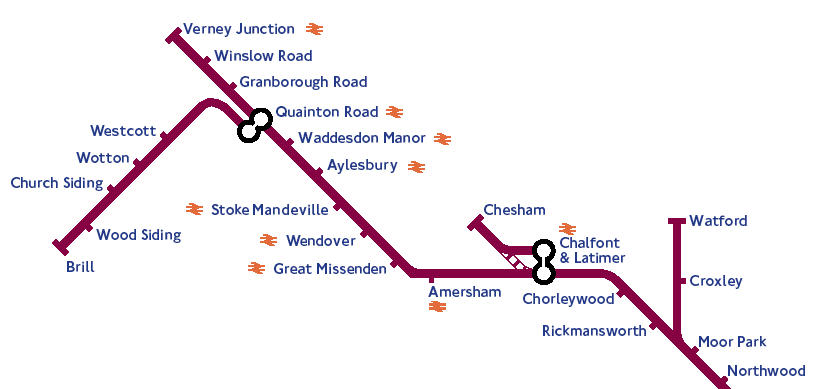
The Metropolitan Railway's grandoise plans for a national network stretching from Manchester to the European continent didn't
materialise (unfortunately, some may consider). The furthest north they managed to get was Verney Junction, after taking
over the ailing Aylesbury & Buckingham Railway. Met Line services on the line started in 1894 and continued until the Met
was incorportated into the London Transport Passenger Board, who did not perceive the line as forming any part of its London
railway responsibilities and duly closed it (along with the Quainton Road to Brill tramway branch).

The Aylesbury to Quainton Road section formed part of the Great Central Railway's service from Marylebone and was closed
to passengers in 1966 as part of Beeching's swingeing cutbacks.

Verney Junction opened in 1868 as northern terminus of the Aylesbury and Buckingham Railway's (A&BR) single track from Aylesbury. The station was at a junction with the London and North Western Railway's (LNWR) Bletchley to Oxford line, 1.75 miles (2.82 km) east of Steeple Claydon, and constructed to a rudimentary design at the cost of the A&BR, whose progress it viewed with disfavour.

Plans to extend the railway north to Buckingham never materialised and Verney Junction remained remote with a few cottages for tenants of Claydon House estate. Claydon's occupant, Sir Harry Verney, was on the board of the A&BR which was chaired by the Duke of Buckingham, and he invested heavily in the scheme. There being no settlement from which the station could take its name, it was named in honour of Sir Harry, who was later to have another nearby station – Calvert – named after him; he had been born Harry Calvert, and took the surname Verney in order to inherit his late cousin's estates in 1827

The A&BR initially began advertising services to and from Banbury, Oxford and Bletchley but the LNWR attempted to isolate the A&BR by encouraging passengers to take its longer route to Aylesbury via Bletchley and Cheddington. The A&BR turned to the Great Western Railway (GWR), with whom it managed Aylesbury, to agree to services over the GWR's Wycombe Railway; the Wycombe line was converted to standard gauge on 23 October 1868 and A&BR services were reinstated.

The GWR worked the A&BR for more than 20 years, turning down the chance to acquire it in 1874, although for the first six years the route was operated by the A&BR's own staff, except for footplate crews who were GWR employees. Traffic was initially "almost non-existent" due to Verney Junction's rural locality, but the Metropolitan Railway under the influence of Sir Edward Watkin nevertheless saw an opportunity for growth and absorbed the A&BR on 1 July 1891. The A&BR would be the line that the London Extension of Watkin's Manchester, Sheffield and Lincolnshire Railway (MS&LR) would meet at Quainton Road. In anticipation of the connection, the A&BR was doubled by 1897 and the Metropolitan extended its line from Chalfont Road to Aylesbury in 1892.
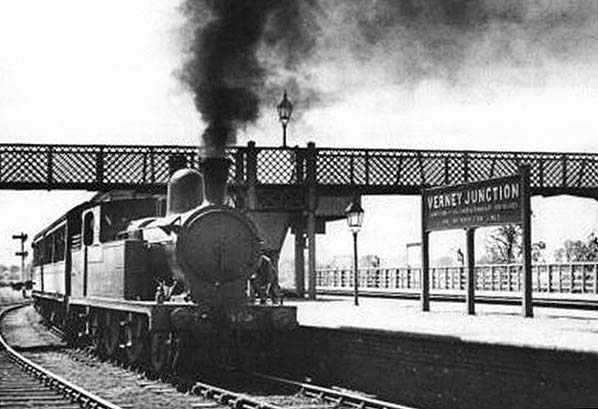
Not long after the Metropolitan reached its northern outpost, Verney Junction was elevated to main line status with the opening of the MS&LR's London Extension (later to be known as the Great Central Railway). Around the same time, the Metropolitan inaugurated a service of through trains between Baker Street and Verney Junction, although this could hardly be said to be merited on the basis of traffic. From 2 April 1906, all Metropolitan services north of Harrow South Junction to Verney Junction came under the control of the Metropolitan & Great Central Joint Committee which had been set up by an Act of Parliament to manage the companies' joint lines.

The Metropolitan opened another intermediate station on the A&BR at Waddesdon in 1897, adding to the three existing stations at Grandborough Road, Quainton Road and Winslow Road which had opened in 1868. A new Pullman service was introduced in 1910 as part of a drive to attract first-class paying passengers from the Great Central; two Pullman coaches named "Mayflower" and "Galatea" were used on alternate weeks between Verney Junction, Chesham and London.

The Metropolitan was vested in the London Passenger Transport Board (LPTB) on 1 July 1933 and freight and passenger workings to Verney Junction continued in trains repainted with the London Transport lettering. However, little over three years later, the LPTB decided to discontinue suburban services beyond Aylesbury and in consequence two Metropolitan outposts were closed — the Brill Tramway ended on 30 November 1935 and passenger services ceased between Quainton Road and Verney Junction on 6 July 1936 when the line was singled. London Transport did, however, reinstate a limited service between 3 May 1943 and 29 May 1948 for war workers, but there were only one or two daily services and these were not widely advertised.
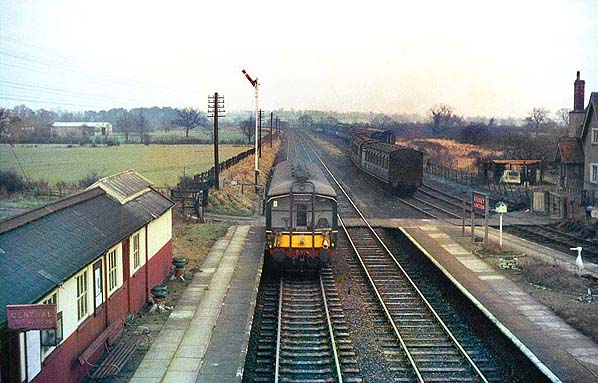
Although the two World Wars brought an increase in freight traffic from Verney Junction to London, with considerable volumes of freight passing through the station's transfer sidings, the post-war period saw a decline in the station's fortunes. The closure of the Aylesbury-Verney section by the LPTB in 1936, severing the connection to Buckingham, was followed by the removal of one of the line's tracks on 28 January 1940. In the same year, freight traffic through Verney Junction was substantially diminished by the construction on 14 September 1940 of a connecting spur between the LNWR and GCR lines at Calvert which enabled freight from the Oxford-Bletchley route to work south over the Great Central Main Line without having to pass over the Verney Junction-Quainton Road section.
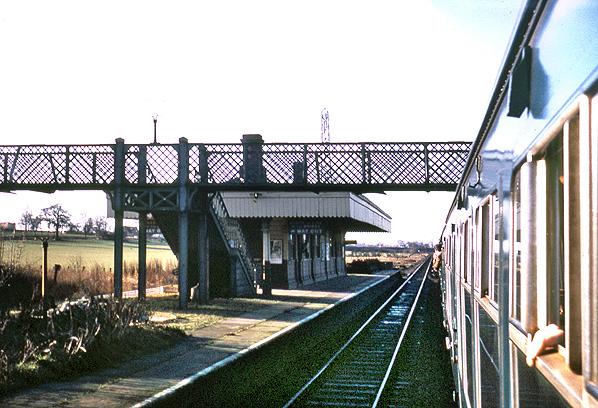
By the end of 1940, Verney Junction was effectively left "severed from its purpose", having little usefulness other than as a rural interchange for local services. It played a useful part in the transfer of goods between the interconnecting lines, but passenger traffic declined in the face of the availability of more direct routes to and from Banbury and Oxford. Goods services were withdrawn in 1964 and later that year the line to Buckingham was closed. The station closed completely when all passenger services were withdrawn in 1968.
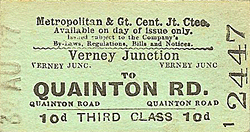
After closure, the track on the northern section of the A&BR between Verney Junction and Winslow Road was retained until the early 1960s, including the former Metropolitan sidings which were subsequently used for storing veteran railway vehicles

The permanent way from Quainton Road to its connection with the Varsity Line has been closed and lifted. A single-track freight line from Bletchley to Bicester was retained and then abandoned in place in 1993; the track remains rusted beyond use and in overgrown state, although modern signage still warns travellers to watch for approaching trains. Of the station itself, the stationmaster's house remains as a private residence and the station ticket office has become a private garage. The platform edges have also survived in a dilapidated state. The stationmaster's house's garden occupies the former Metropolitan trackbed.

Work has begun to re-open the line between Bicester Town and Bletchley in about 2019 as part of the East West Rail Link project but Verney Junction station is to remain closed as it would serve no significant settlement.

This cache is away from the station due to the ongoing works but is only a short walk away. Please use the footpath from the crossing NOT the private driveway to access the cache. The footpath is to the right of the driveway and currently accessed from the track bed.
